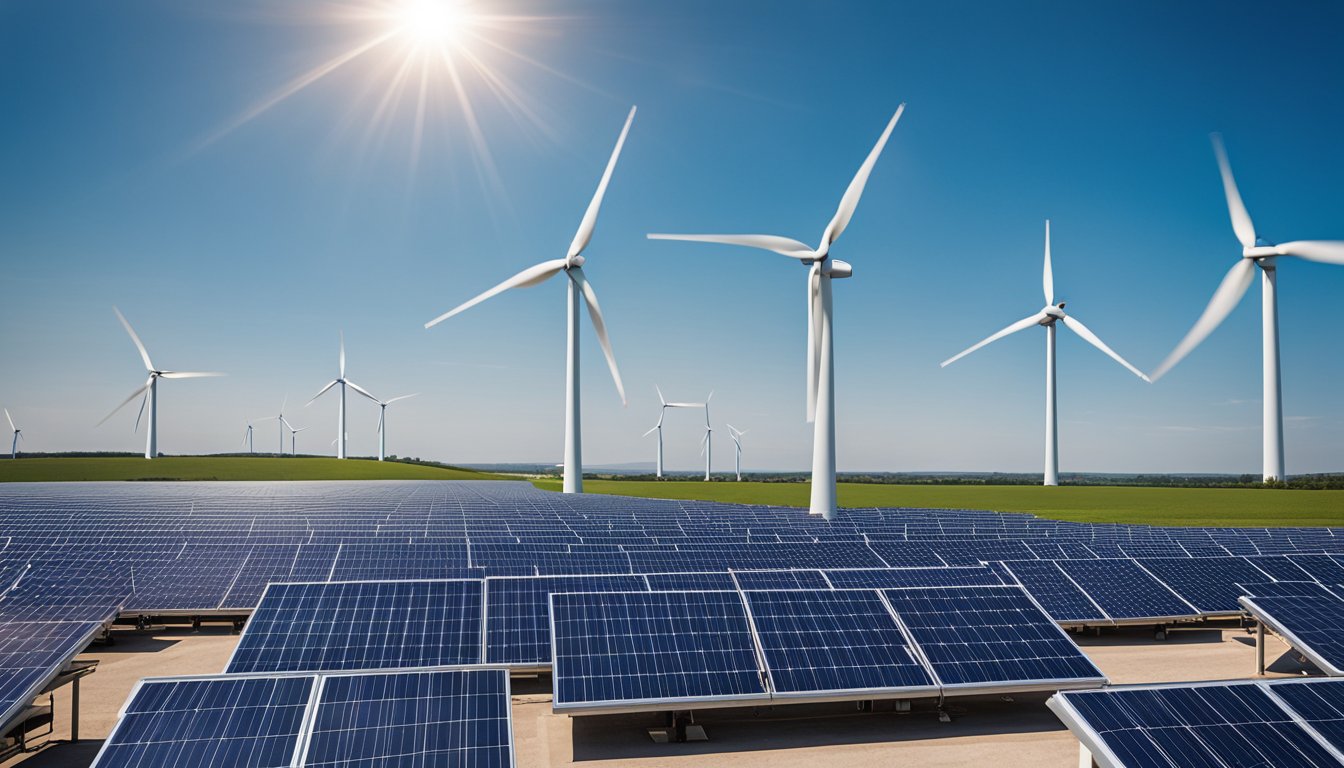Late updated: 21 Jul 2024 14:07
Written by: Eleanor Hartman
Switching To Sustainable Energy Providers In The UK: A Comprehensive Guide
Switching to sustainable energy providers in the UK is more important than ever. As we strive to reduce our carbon footprint and combat climate change, finding the right green energy supplier can make a significant difference. Choosing a provider that offers renewable electricity and green gas options is not only environmentally friendly but also a step towards a more sustainable future for all of us.

In the UK, there are several reputable green energy suppliers to consider. Names like Ecotricity, Good Energy, and Octopus Energy have emerged as leaders, offering various options to help consumers reduce their reliance on fossil fuels. Each supplier comes with its own set of tariffs and benefits, so it’s essential to compare their offerings to find the best fit for your needs.
Switching to a sustainable energy provider is not just about reducing emissions; it's also about making an informed decision that aligns with our values. Understanding the different green energy options available helps us make a choice that balances environmental impact and cost efficiency.
Key Takeaways
- Switching to sustainable energy providers helps reduce carbon footprints.
- Compare green energy suppliers like Ecotricity, Good Energy, and Octopus Energy.
- Make informed decisions that balance environmental impact and cost.
Understanding Sustainable Energy in the UK

Sustainable energy in the UK involves diverse renewable sources, green tariffs, and government policies aimed at reducing climate change impacts and achieving net zero emissions. The focus is on renewable electricity and gas to reduce greenhouse gas emissions and promote environmental sustainability.
The Landscape of Renewable Energy Sources
Renewable energy in the UK comes from several key sources.
Wind power is a major contributor, accounting for around 29.4% of electricity generation. Offshore wind farms are particularly prominent, given the UK's geography.
Solar power contributes approximately 4.9%, harnessing sunlight to produce clean energy.
Biomass energy, which involves burning organic materials, adds about 5% to the renewable mix.
Hydropower, including tidal energy, provides around 1.8%, tapping into water flows to generate electricity.
These sources collectively support the transition to sustainable energy, addressing climate change and reducing greenhouse gas emissions.
Green Credentials and Tariff Types
Understanding the credentials of green energy providers is crucial for consumers.
Ofgem regulates energy tariffs to ensure transparency and fairness. Some providers may engage in greenwashing, so it's important to verify their claims.
Green tariffs generally fall into two categories:
-
100% renewable electricity tariffs, sourcing all electricity from renewables such as wind, solar, and hydroelectric power.
-
Carbon offset gas tariffs, where emissions from gas consumption are offset through projects like tree planting or renewable energy investments.
Consumers should look for certifications and labels that validate the green credentials of their providers.
Governmental Policies and Energy Regulation
Government policies play a significant role in shaping the sustainable energy landscape in the UK.
The UK government has outlined strategies to achieve energy independence and net zero emissions. This includes reducing reliance on Russian oil and gas and investing in renewable energy technologies.
Initiatives like offshore wind expansion and sustainable aviation fuel (SAF) development are part of these strategies. Moreover, efforts such as railway renationalisation aim to enhance environmental sustainability.
Organisations like Ofgem oversee the implementation and regulation of these policies, ensuring that the move to sustainable energy is both effective and fair.
Through these policies and regulations, the UK aims to lead in reducing the environmental impact of its energy sector.
Choosing Your Green Energy Provider
Choosing a sustainable energy provider involves comparing tariffs, understanding the transparency of green claims, and the process of making the switch. Here's a comprehensive guide to help you navigate these steps effectively.
Comparing Green Energy Tariffs
When comparing green energy tariffs, it's essential to consider both price and the type of energy provided. Some suppliers, like 100Green and Octopus Energy, offer competitive rates for fully renewable electricity.
We should also look at whether the supplier provides green gas. It's less common and usually more expensive, but some companies cover a percentage of green gas in their tariffs. For example, only 100Green offers 100% renewable gas.
A table summarising the offerings of popular suppliers may be helpful:
| Supplier | Electricity | Green Gas Coverage |
|---|---|---|
| 100Green | 100% | 100% |
| Ecotricity | 100% | Partial (up to 25%) |
| Good Energy | 100% | Some (typically 10-20%) |
| Octopus Energy | 100% | None |
By comparing these details, we can make an informed choice based on both environmental impact and cost-effectiveness.
Assessing Green Claims and Transparency
Not all green energy providers are created equal. We must scrutinise claims of renewable energy to ensure they are genuine. Companies such as Ecotricity and Good Energy score highly for buying and selling renewably sourced power.
Transparency about the origin of energy and business practices is crucial. Providers should clearly state the percentage of renewable energy in their mix and disclose involvement in fossil fuels. For instance, British Gas's parent company Centrica has direct ties with fossil fuels, which might influence our decision.
Green energy certifications and accreditations can also indicate credibility. Trustworthy suppliers will often have certifications from recognised bodies, which are worth checking.
Making the Switch to a Sustainable Supplier
Switching to a green energy provider is usually straightforward. We start by selecting a supplier that meets our needs and fetching a quote.
Most suppliers handle the transition process, ensuring no disruption to our power supply. We only need to provide our current energy details and a meter reading.
It’s also useful to time our switch to align with the end of our current tariff. Early exit fees from existing contracts can sometimes offset the savings made by switching. By planning ahead, we can avoid unnecessary charges and start benefiting from renewable energy sooner.
By considering these factors, we can successfully transition to a green energy provider that aligns with our values and needs.
Frequently Asked Questions

Switching to a sustainable energy provider in the UK offers multiple benefits, including environmental impact reduction and potential financial savings. Below, we address common queries to help guide the transition.
What steps should I follow to switch to a green energy supplier in the UK?
First, compare green energy tariffs using reliable resources such as Ofgem and reputable review sources.
Next, select your preferred green supplier and initiate the switch. Typically, this involves signing a new contract and notifying your current supplier.
Finally, monitor the switch process, which should complete within 5 working days if scheduled promptly.
Which company is considered the best provider of sustainable energy for UK households?
Several companies stand out in the green energy sector. 100 Green (formerly Green Energy UK) is notable for offering 100% renewable gas.
Good Energy and Octopus Energy are highly rated for their commitments to renewable energy. Both received high scores, particularly in categories related to buying and selling renewable power.
How do the tariffs for green energy in the UK compare to those of conventional energy?
Green energy tariffs can vary but are becoming increasingly competitive with conventional energy prices.
While some green tariffs may be slightly higher, the long-term benefits and potential for price stability as renewable technologies advance make them an attractive option for many households.
What are the financial implications of switching to a renewable energy supplier in the UK?
Switching to a renewable energy supplier can have varied financial implications.
While initial tariffs may seem competitive or slightly higher, there are often long-term savings through price stability and reduced environmental taxes. Additionally, some green energy suppliers offer incentives such as lower rates for consumption monitoring and energy efficiency improvements.
Can you provide a comparison of the various green energy companies operating in the UK?
100 Green offers 100% renewable gas, a unique feature in the market.
Ecotricity focuses on sustainable electricity sourced from wind and solar.
Good Energy and Octopus Energy both provide high percentages of renewable electricity and have consistently received high ratings for their service and sustainability efforts.
What are the environmental benefits of choosing a sustainable energy provider in the UK?
Opting for a sustainable energy provider significantly reduces carbon footprints.
It supports the renewable energy industry, fostering innovation and infrastructure development.
By investing in green energy, we contribute to a cleaner, healthier environment for future generations while also potentially benefiting from reduced fossil fuel dependency.